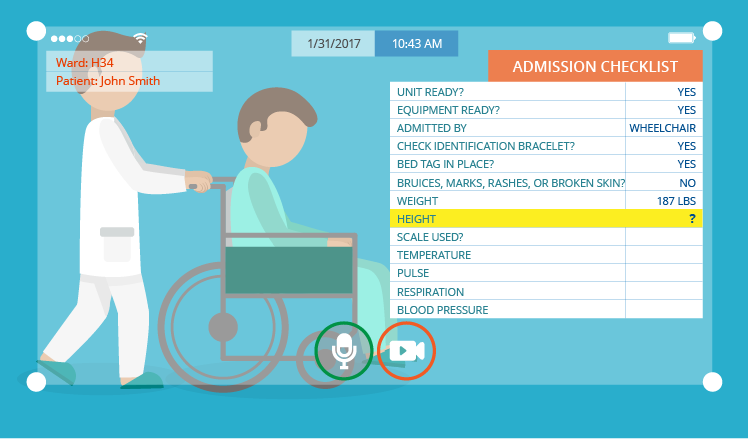According to NIH, the 65-and-over population in the US is expected to nearly double over the next three decades, from 48 to 88 million by 2050. The aging population puts an inevitable burden on healthcare with the increasing number of Medicare and Medicaid patients in need of special help from hospitals, assisted living facilities, home care agencies and other providers.
For this reason, healthcare professionals will be those to tackle the challenges related to the growing workload, and the first to feel the change are ADT nurses. They will have to handle the rising amount of patients admitted to the facility while keeping up with the formal procedures, standards and processes.

How nurses will be tackling the ADT challenges with emerging technologies
Currently, nurses can already delegate some routine part of their ADT workflows to mobile applications. But this is not an ultimate option, as nurses still need their hands free to assist patients, which makes tablets, smartphones and watches a temporary way out.
The emerging era of AR devices, particularly glasses, can be a promising tool to overcome the inconvenience related to other mobile devices. Specialized applications created just for the AR-enabled glasses are the type of custom medical software to simultaneously streamline nursing workflows and improve care quality by turning tiresome procedures into a casual conversation with a patient and the system.
Accordingly, the ADT application for AR-enabled glasses can help caregivers to reach the following objectives related to ADT:
- Decrease the workload on ADT nurses by automating a part of routine tasks and introducing hands-free experience
- Improve patient satisfaction by eliminating certain formalities, missed steps or action items emerging due to gaps in paper-based or desktop, EHR-only workflows
- Ensure more well-timed and organized processes with all the important notifications sent right to the nurse’s glasses
Application functionality
The functionality within the ADT solution can be divided into three main groups:
- The ADT process
- Scheduling and reservation
- Patient identification
The ADT process
The functionality for patient admission with emergency and / or inpatient settings (for acute-care or short-stay hospitals) to document initial patient data during the admission process. Includes reservation of a ward or a bed, recording of vitals, filling in the admission questionnaire and more.
The functionality for patient discharge. Enables guiding, consulting and supporting nurses with the pre-configured list of arrangements.
The functionality for patient follow-ups. Allows to ensure quality care from admission to discharge via such features as tracking the care time and location, monitoring assigned and completed tasks, and informing a patient's family members and / or escorts about any important events.

Each functional set also includes smart checklists of the process steps, expandable and configurable through the server. Nurses could interact with the smart checklists via voice recognition and control capabilities, marking checked boxes and receiving hints on the next steps and more. There can be a variety of numerous checklists, depending on a caregiver’s needs.
Scheduling and reservation
Voice and gesture control. Nurses can use their voices and gestures to facilitate multiple tasks. For example, they can raise a hand to make the list with options appear, choose the list item and activate it with the pushing gesture. At the same time, a health specialist can ask the ADT application to call someone from the care team, check the insurance information and more.
The patient grid and nurse shifts. This functionality is useful for a senior nurse of the shift and Chief Nursing Officer to keep in touch with nurse schedules.
Bed / ward reservation. Nurses can ask the ADT application to show the list of free beds or wards, check the items ready for reserving in real time and book the chosen bed / ward. This feature is especially beneficial for acute-care or emergency admissions.
Call for assistance. In case an ADT nurse needs a skilled consultant to help out in any trouble or difficulty, the system can contact another nurse or physician.
Patient identification
Patient registration and fast identification. During the admission, nurses can use their voices and gestures to register the patient in the EHR system without even touching it. They can create and edit each patient's information, including name, address, gender, age, ID, etc. Nurses can also record various patient biometrics and then quickly identify the patient during the next admission or when needed. The application’s biometric identification allows recognizing the patient using fingerprints, a voice sample, iris scan or face recognition.
Patient merge. This functionality implies mechanisms for duplication prevention with phonetic validation of name, gender, date of birth and other unique identifiers (e.g. SSN or NHS number). It also allows to merge two clinical records of the same patient, whenever a record is created by mistake.
Patient cross-referencing. The feature supports the correlation of patients between multiple facilities without the need to define or compromise any specific organization policies through the Patient Identifier Cross-referencing system (PIX).
The ADT application: A use case
Admission
Emergency admission
If a patient is admitted to an acute-care hospital in critical condition, health specialists first have to stabilize him or her. Using the AR device with the installed solution, nurses can record vital signs and identify the patient using the information provided by family members, patient SSN, fingerprints and more. Then the ADT nurse selects a bed / ward, which initiates new task assignment for another nurse to prepare or check the accommodation conditions. The nurse responsible for wards / beds, receives the assignment in real time and either prepares / checks a regular bed or makes sure a temporary bed is prepared.
The whole process goes along in accordance with standard procedures and appropriate checklists. The ADT application automatically logs video / photo / voice data, the nurse marks checklist boxes via voice or gestures. After the preparations are completed, the bed / ward gets the green status and the ADT nurse gets a notification. Then the ADT nurse accommodates the admitted patient when his or her condition is stable.
Planned admission
When a patient arrives at the hospital’s reception hall or admitting office for short-stay care, the planned ADT data is already entered into the ADT system by the nurse. Accordingly, the ADT nurse (or the floor nurse, depending on the workflow) has already reserved the bed or ward, it is prepared and checked the same way as in the emergency admission scenario. The ADT nurse also gets the notification about the patient’s arrival and meets the individual in the reception hall.
The ADT nurse welcomes the patient and family members, confirming the patient’s identity (name, gender, date of birth, SSN or NHS number). Moreover, the nurse can also offer the patient to record biometrics for fast patient identification in the future. The patient is examined, his or her vitals are recorded, CBC and urine tests are taken. The nurse also fills in the admission questionnaire.
The health specialist is guided through all the procedure stages and marks stages as complete using voice or gestures.
Then the nurse accompanies the patient into the ward, answering questions and instructing on the hospital’s internal rules, intercom use, TV remote control, bed control, etc. Upon completing the procedure, the nurse marks the admission checklist as done.
Transfer
The process of planning and preparing the transfer of a patient to another patient / nursing unit or facility is similar to admission with bed / ward reservation, task assignment and more. The difference is that the ADT nurse also needs to order additional equipment (e.g. a wheelchair), schedule transportation and assign the task of room cleaning. Moreover, the patient wouldn’t need additional examination.
Discharge
When planning discharge, the ADT nurse also has a pre-configured checklist / task list and list of arrangements within the ADT application. The health specialist checks documentation to ensure proper forms and signatures, reserves medical equipment (e.g. a wheelchair) and notifies the patient’s family members – all with the help of the ADT application.
After the patient (or their family member) gets discharge documents, the nurse assists the staff in escorting the patient out of the facility. The ADT nurse then marks the bed / ward for disinfecting and preparing for the next admission and assigns this task to another nurse according to the workflow.
When the ADT nurse marks the discharge procedure complete, the ADT system automatically generates a discharge report with date and time of discharge, special medical instructions for the patient and other information. The ADT nurse checks the report and edits it if necessary. Then the ADT system saves this report and marks the final discharge stage complete.
Adopting the ADT application: Custom vs. out-of-the-box
While there are currently no packaged ADT applications available for AR-enabled glasses, the question of building versus buying is always relevant. When the market of AR applications for healthcare will burst with alternatives, caregivers will have to decide.
Considering the custom medical software option, providers may turn it down because of time and budget required. However, even the most functional out-of-the-box solution will need tailoring. The tailoring process involves a number of ifs and buts: a vendor may reject to add some needed functional elements, other features may require additional code. Fine-tuning also takes time, which can lead to unwanted delays in application adopting. In other words, providers can end up with everything they actually wanted to escape by buying a packaged solution.

